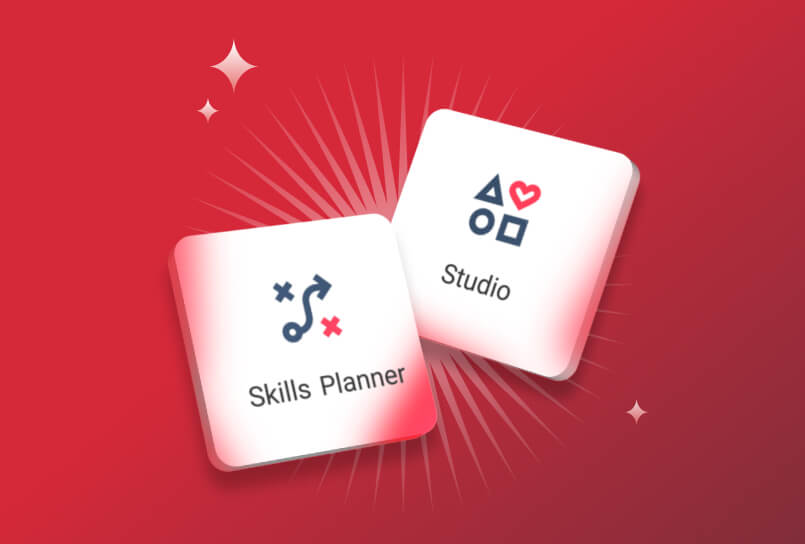The importance of skill development and where to start
Learn why encouraging employees to expand their skill sets is in your business’s best interest

Skill gaps pose an existential threat to businesses everywhere—and unfortunately, the risks keep growing. 70% of executives cite these shortages as a top external challenge and fear that workers aren’t reskilling and upskilling fast enough to reap the benefits of new technologies.
Consequently, skill development needs to be a priority for every organization. Without a structured approach to developing the capabilities your business needs, a lack of in-demand expertise will threaten your workforce’s output levels and wreak havoc on your bottom line.
In fact, research from McKinsey reveals that more than one in four leaders believe that failing to capture the needed skills could directly harm their financial performance and indirectly impede their efforts to leverage value from AI. To prevent ever-widening skill gaps from becoming your business’s reality, find out what it takes to create a skill development program that will empower everyone to reach their full potential.
What is skill development?
Skill development is the process of improving existing abilities or learning new ones to enhance performance and meet job requirements. It involves training, practice, and education to build competencies that support career growth, adaptability, and productivity in changing work environments.
Why is continuous upskilling and reskilling so valuable?
Skill-building will never be a one-and-done process. As the speed of digital innovation accelerates and the half-life of learned knowledge shrinks, employees will need to continue honing new competencies to keep pace. Since the World Economic Forum predicts that nearly a quarter of all jobs will change within the next five years and 69 million new jobs will be created, employees must keep developing their skills so they’re qualified to take on these shifting responsibilities.
In-demand professional skills for 2025 and beyond
While any skill-building efforts are likely to be beneficial, some capabilities will outrank the rest in terms of importance and urgency. Here are a few skills that are likely to be in high demand for the foreseeable future:
#1. Digital literacy and tech skills
Digital literacy isn’t just for IT; all employees must hone technical skills to capitalize on the latest wave of AI innovations. Although two-thirds of executives say they won’t hire someone without AI skills, just 25% of companies plan to offer AI training this year. Rather than exacerbating this discrepancy, leaders must develop learning pathways so employees can hone the skills needed to harness AI effectively.
#2. Critical thinking and problem-solving skills
Professionals of all levels must develop strategic mindsets. Employees will be expected to propose, implement, and follow data-driven strategies that align with specific business goals and predetermined KPIs. When challenges arise, people need to be comfortable thinking outside the box and harnessing the systems they have to architect solutions to obstacles that they may not have encountered before.
#3. Emotional intelligence and interpersonal skills
Now that burnout rates are reaching record levels, leaders must develop new strategies to promote well-being and ensure employees feel recognized, supported, and empowered to do their best work. Beyond the need for executives to hone these skills, employees must also develop their emotional intelligence to become considerate and supportive colleagues. Everyone will occasionally find themselves in the middle of emotionally charged situations such as disagreements between employees and managers and communication challenges. These conversations must be handled tactfully to ensure all parties walk away feeling understood and supported.
#4. Adaptability and flexibility
From the proliferation of GenAI to the shift towards skills-based operating models, employees are experiencing higher levels of workplace change than ever before. It’s up to every worker to learn how to navigate these shifts effectively and support their colleagues if any potential disagreements arise along the way. Some teams may be hesitant to embrace bold new ways of working, so it’s up to leaders to role model these behaviors to encourage everyone to shift their mindsets.
#5. Leadership and collaboration skills
Employees at all levels of your organization must hone leadership skills so they can feel confident driving projects and play an active role in shaping the future of your business. As skills-based work continues to become more common, employees will find themselves collaborating with more diverse groups of peers so they must become comfortable working with different people and sharing their ideas.
3 best practices to help your workforce hone new skills
If you’re looking for pointers to help empower your people to expand their skill sets, here are a few best practices:
#1. Identify skill gaps before they emerge
Now that the half-life for technical skills has dropped to just 2.5 years, upskilling and reskilling must become continuous processes. The rise of AI demands an extra layer of focus on skill development. Understanding how AI will specifically impact your industry and roles is key to identifying the skills to target when creating your skill-building initiatives. With the help of skills intelligence systems like Gloat Skills Foundation, HR teams can identify where capabilities are falling short before knowledge gaps snowball into bigger problems.
#2. Prioritize experiential learning opportunities
You can’t rely solely on L&D content for skill-building. If your people don’t have the chance to put the lessons they’re learning into practice, they’re likely to disengage with the curriculum and they won’t develop the capabilities they need. To get employees excited about upskilling, HR leaders must integrate hands-on learning experiences into their strategy. Talent marketplaces make it easy to identify projects, gigs, and shadowing opportunities that align with the skills your people need to build.
#3. Cultivate connectivity with mentorships
If there’s one initiative that can simultaneously improve skill-building and bolster employee experience, it’s mentoring. From an employee perspective, mentorships give people the chance to network and build relationships with their colleagues across the organization. In addition to cultivating connectivity, co-learning schemes are a powerful tool for skills since employees can see what their more experienced colleagues are doing and ask them questions directly. At the same time, employees who step into the mentoring role will develop their leadership skills and coaching abilities.
Core components of a skill development plan
Given the importance of upskilling and reskilling, it’s in every leader’s best interest to devise a skill development plan to encourage employees to amass the knowledge they need. When you’re launching your strategy, make sure your development plan has the following components:
#1. Skill gap analysis
Before leaders can bridge skill gaps, they must take stock of the capabilities their people have as well as existing knowledge shortages. To see where their workforce skills might be falling short, leaders can conduct a skill gap analysis to identify the learning and development initiatives they should prioritize. Once HR is aware of any knowledge gaps, they can create strategies to overcome existing shortages, including hiring externally for new skills or redeploying or reskilling internal talent.
#2. Skills benchmarking
As leaders begin crafting their workforce skills plans, it can be helpful to get an idea of how their workforce’s capabilities compare with organizational and industry-wide standards—which is exactly what skill benchmarking provides. Executives can measure employees’ skills and skill levels to determine whether an individual has the required skills to perform a role and identify upskilling opportunities to bridge knowledge gaps.
Skills intelligence systems make this level of comparison and analysis possible. Without these AI-powered platforms, it’s next to impossible to explore how one workforce’s capabilities compare to another’s. As skills intelligence goes mainstream, more organizations can evaluate their competitors and adjust their skills plans accordingly.
#3. Development plans
Once leaders have an in-depth understanding of their workforce’s skills and any emerging knowledge gaps, they must architect a plan to help employees build the capabilities outlined in their workforce skills plan. Employees need multiple pathways to hone new skills, including having the opportunity to pitch in on projects and gigs so they can build on-the-job experience.
A talent marketplace that matches people to open opportunities based on their experiences and the skills they wish to build can be a game-changer for employee development. The platforms can also help employees find mentors so they can receive one-on-one guidance.
#4. Evaluation and monitoring
A skill development plan isn’t complete once leaders have drafted it. Instead, executives must carefully monitor their organization’s skill-building efforts to determine who is participating in development opportunities and how these opportunities are bringing employees closer to completing their overarching skill goals.
Leaders must also continue to check in with skills intelligence systems so they can get an idea of which capabilities are growing more important and which are declining based on market and industry trends. Based on this information, executives may deprioritize a certain skill so they can shift gears and focus on more in-demand expertise.
The future of skill development in a rapidly changing world
Skill development has always been important but recent events are raising the stakes. We’re now in what’s often called “The Fourth Industrial Revolution”, a time in which advances in AI and automation is revolutionizing the way we work.
Since the pace of change is accelerating and knowledge is becoming obsolete faster than ever before, developing new capabilities can no longer be an afterthought. Instead, research points to skill development as a prerequisite for success.
The World Economic Forum predicts that half of all global employees will need reskilling by 2025, as the adoption of technology increases. While the rise of AI and automation isn’t going to push employees out of the job market as some people once feared, it will create millions of new roles. And although that’s good news, these jobs are going to come with new sets of required expertise, which is where the increased need for skill development comes into play.
Want to learn about the newest AI innovations that will help take your skill development plan to the next level? Find out more about Skills Planner and Studio.





